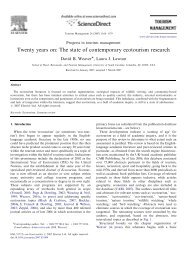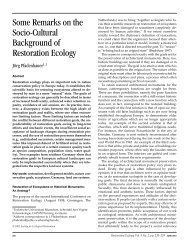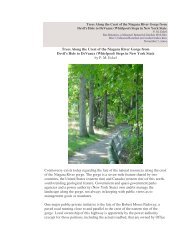Economic Impacts of Parks, Rivers, Trails and Greenways
Economic Impacts of Parks, Rivers, Trails and Greenways
Economic Impacts of Parks, Rivers, Trails and Greenways
You also want an ePaper? Increase the reach of your titles
YUMPU automatically turns print PDFs into web optimized ePapers that Google loves.
Necedah National Wildlife Refuge available at http://midwest.fws.gov/Necedah/Washington Conservation Corps, http://www.ecy.wa.gov/programs/sea/wcc/index.html,<strong>and</strong> communication with staff, Nick Mott <strong>and</strong> Lorie Bamer; July 15, 2004.3.1.6 Additional InformationConservation Corps ProgramsYouth conservation corps programs are usually full-time <strong>and</strong> <strong>of</strong>fer the opportunity for workexperience <strong>and</strong> education to young people within the framework <strong>of</strong> community service.There are about 120 corps programs nationwide (listed at the bottom <strong>of</strong> this section),enrolling 26,000 participants annually. There are 21 statewide programs <strong>and</strong> many localitiesmanage their own programs, bringing the number <strong>of</strong> states with conservation corps up to32. Participants are usually educationally or economically disadvantaged young peoplebetween the ages <strong>of</strong> 18 <strong>and</strong> 25, <strong>and</strong> most participants are persons <strong>of</strong> color. More than halfwere high school drop-outs when they joined <strong>and</strong> 80% did not work during the year beforeenrolling in the corps. Nearly half reported that their households were receiving some form<strong>of</strong> public assistance—AFDC, general relief, or food stamps. While working in the corps,participants receive a stipend, generally around minimum wage. Often, graduates <strong>of</strong> theprogram are eligible for post-program educational stipends or small cash awards.Total funding coming from grants, contracts <strong>and</strong> contributions on the federal, state <strong>and</strong>local level for all conservation corps programs is $338,746,537. The breakdown <strong>of</strong> corpsfunding sources is shown below.Table 4. Source <strong>of</strong> Conservation Corps FundingState/County/Municipal Appropriations & Grants 42.3%Federal Grants 26.4%State/Local/Private Fee-for-Service Contracts 21.0%Federal Fee-for-Service Contracts 4.8%Other 5.5%TOTAL 100%A cost benefit analysis was performed on the four youth corps programs that were thelargest, most established corps programs within a larger study. These programs hadcompleted the program startup phase <strong>and</strong> thus effectively represented the stable functioning<strong>of</strong> youth corps programs. The monetary results demonstrate how valuable these publicinvestments are. They produced an average <strong>of</strong> almost $600 in net benefits to society foreach participant as shown below. Non-monetary benefits may include impacts on theparticipant’s civic, social, <strong>and</strong> personal development, reduced risk behavior, strengthenedcollaborations <strong>and</strong> community networks as well as other indirect benefits to community.The study showed that there was a statistically significant reduction in the percentage <strong>of</strong>individuals arrested after participating in the corps program.16














